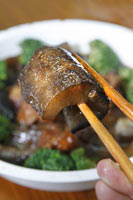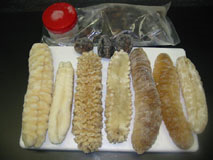Eggs and sperm are released into the water. When an egg is fertilized and hatches, the tiny planktonic larva drifts with the ocean currents. The larvae eventually settle onto the sea floor and develop into adults.
The species of sea cucumber farmed in the Northern Territory is Holothuria scabra, also known as Sandfish. They are found in many countries from east Africa to the eastern Pacific. Their usual habitat is shallow tropical waters, usually less than 20m deep, such as sheltered areas with high levels of nutrients, including muddy substrata and seagrass beds. They are usually found partly buried in mud or sand.
Sea turtles, crustaceans, many fish, and humans are predators of sea cucumbers.
The Macassans, from Indonesia, travelled across the Timor sea to interact with the local Aborigines in the Northern Territory and to fish for this high value product since the 1700’s. Estimates from the 1800s, based on historical data, indicate annual catches of around 800 tonnes were common.
Presently there are six fishing licenses for sea cucumber in the NT owned by one company, Tasmanian Seafoods. There is currently, no indigenous fishing and no recreational fishing of sea cucumbers No further fishing licenses will be issued.
Throughout the Asia-Pacific region sea cucumbers are considered a delicacy and are traded as trepang or bêche-de-mer. Sandfish (Holothuria scabra) is the most valuable species and has been successfully cultured in many Asia-Pacific countries such as China, the Philippines and Fiji.
Australia's first commercial mud crab and sea cucumber hatchery was opened in 2003 at Hervey Bay in Queensland. It is operated by Bluefin Seafood.
|
Known as "bêche-de-mer " in France, sea cucumber are prized for their gelatinous texture. They have been a delicacy in Chinese cooking since ancient times and are often served at banquets,
The sea cucumber can be cooked in many ways - stewed with ribs, stir fried in black pepper sauce, or boiled in chicken stock. The rather tasteless sea cucumber has the ability to absorb and bring out the flavours of the ingredients in which it is cooked. |
 |
|
When sea cucumbers are handled, or when stressed by predators, they can push their internal organs out of their bodies. These organs can regrow within 2 months.
Prices for sea cucumber can reach US$45 per kilogram. |
|
The Darwin Aquaculture Centre is currently working on two research projects. First, a CRC (Australian Seafood Cooperative Research Centre) funded project on developing and adapting techniques for the culture of sandfish in the NT. Research at DAC has focussed on addressing the two most important commercial bottlenecks, larval settlement and the early nursery phase.
Secondly, a three year ACIAR (Australian Centre for International Agricultural Research) funded project entitled “Sea ranching and pond culture of sandfish (Holothuria scabra) in Asia-Pacific - Trial of sea ranching of sandfish in an Australian Indigenous community”. This project is undertaken in collaboration with James Cook University, the Warruwi Community on South Goulburn Island and The WorldFish Center. Several sites suitable for sea ranching in the NT have been identified. The first large-scale release of juveniles took place in mid 2011. The juveniles should reach a harvestable size of 20cm (400g) in around 12-18 months. |

|
Stocks are becoming depleted due to their popularity. It can take over fifty years for isolated and heavily harvested stocks to recover. To help increase local populations, methods have been developed to get the sea cucumbers to spawn in captivity by using stimulation from heat, movement and alga feeding.
Trade in dried sea cucumber could brings benefits to coastal communities because harvesting, processing and storage is easy and it doesn't need specialised equipment. |
|